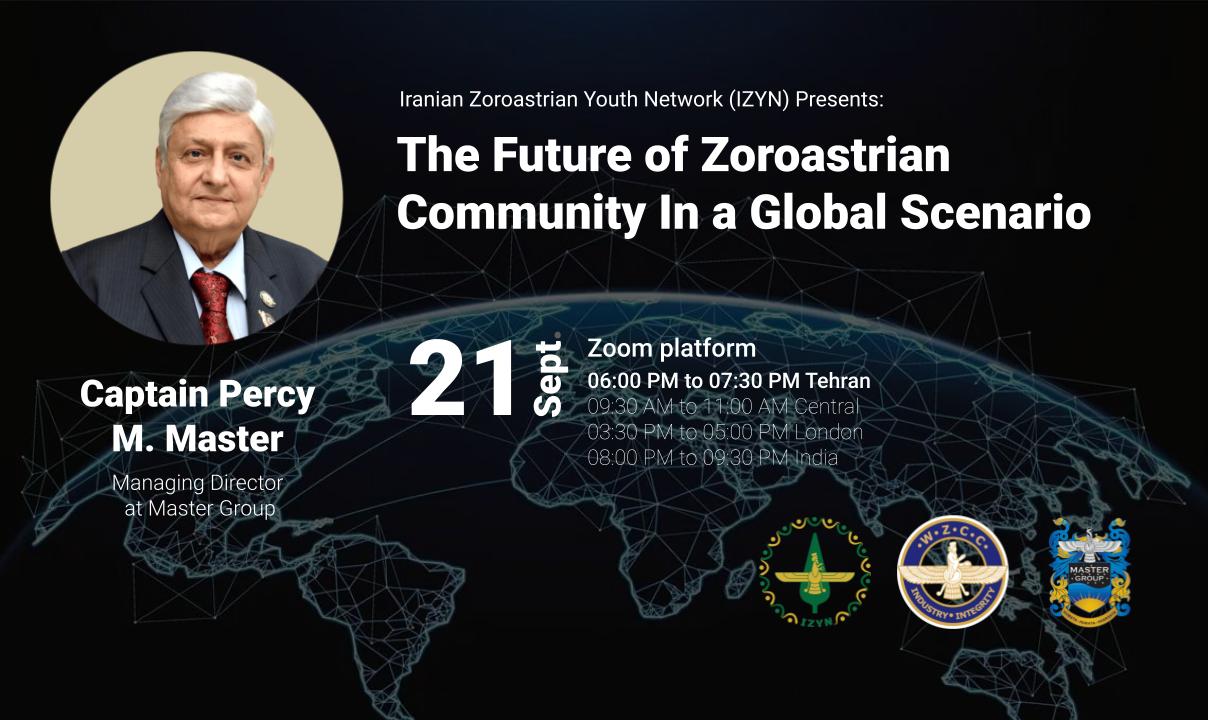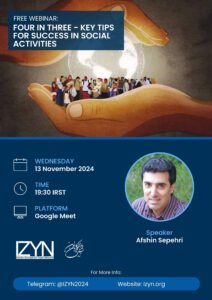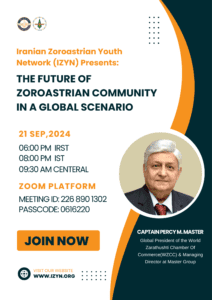On September 21, 2024, the Iranian Zoroastrian Youth Network was honored to host Captain M. Percy Master, the President of the Zoroastrian Chamber of Commerce. Below, you can find the text of his speech titled “The Future of the Zoroastrian Community in a Global Scenario.”
The Future of the Zoroastrian Community
In order to look at the future, we must first look at the past, dwell on the present, and plan for the future Let us briefly look at our roots starting from Ancient Iran which was the cornerstone of greatness. Ancient Iran was a leader, a visionary force that left an indelible mark on the tapestry of human history from the earliest times.
The Persian Empire under Cyrus the Great wasn’t just vast but remarkably progressive. Cyrus pioneered human rights, a concept so advanced in its time that it put many later empires to shame. The Cyrus Cylinder is often referred to as the first charter of human rights, emphasizing tolerance and respect for different cultures and religions.
The influence of the Achaemenid Empire extended far beyond its time. Do you know that the founding fathers of the United States modeled aspects of their new nation on the Achaemenid Empire? They admired its emphasis on justice, governance, and human rights. Thomas Jefferson in particular was inspired by the principles of governance that Cyrus the Great implemented seeing in them a reflection of the values he hoped to embed in American democracy.
Let us now look at the Architectural and artistic achievements of Ancient Iran. The grandeur of Persepolis, with its towering columns and intricate reliefs, stands as a testament to the sophisticated artistry and engineering prowess of the time and there’s evidence that the ancient Greeks modeled these columns.
But there’s so much more. Ancient Iran was a pioneer in postal systems, with the Achaemenid Empire creating one of the earliest and most efficient postal services known to man. This system allowed messages to be relayed rapidly across vast distances, an innovation critical for maintaining the cohesion of their vast empire.
Furthermore, Ancient Iran’s influence extended into the realm of astronomy. The ancient Iranians developed a sophisticated understanding of the stars and planets, leading to the creation of the Zoroastrian calendar; one of the most accurate calendars of its time. Even in metallurgy, ancient Iranians were ahead of their time, producing some of the earliest known steel through innovative techniques that were later refined in medieval Persia and beyond.
And then there’s the unique position of women in ancient Iranian society. At a time when most civilizations relegated women to the shadows, Iran stood out with its progressive stance on gender equality. Women in ancient Iran could own property, manage their own businesses, and even participate in the political arena.
Compared to the severely restricted lives of women in contemporary civilizations, Iranian women enjoyed a degree of respect and autonomy that was nothing short of revolutionary. They were not only seen as vital members of society but also as key contributors to the cultural and economic life of the empire.
Let us now look at Zoroastrianism which is an ancient Pre-Islamic religion of Iran that survives now in isolated areas only and more prosperously in India where the descendants of the Zoroastrian Iranian (Persian) immigrants are known as Parsis.
The Iranian prophet and religious reformer Zarathustra flourished before the 6th century BC. Zoroastrianism is the first monotheistic religion in the world.
Islam won a decisive victory in 635 over the armies of Yazdegerd III the last Sasanian emperor. Islam in principle tolerated the ancient religion but conversions by persuasion or force were used in many provinces. Zoroastrianism fermented rebellion and thus brought persecution upon itself.
There were pockets of survival notably in Persis the ancient center of the Achaemenid and Sasnian Empires. The religious books were produced to save the essentials of the religion from threatened disaster. The disaster did occur but exactly why and how it is not known. Zoroastrians survived in a land as a prospective minority in small enclaves at Yazd and Kerman.
The student of religion is often confronted by several problems concerning Zarathustra. The first concerns are the dates of his birth and death which cannot be ascertained with any degree of certainty. Although some scholars continued to accept as traditional the approximate birth and death dates indicated in the later text of the Avestha books.
According to which the Zarathustra lived from 628 to 551 BC the Sasanian period was from 224 to 651 CE genuinely reflected the teachings of Zarathustra. The Avestha book contains amongst the other writings of the Gathas the set of hymns composed by Zarathustra in the old Avestha language The aforementioned sources indicate that Zarathustra was probably a priest from the ancient Iranian religion having experienced the vision from Ahura Mazda who appointed him to preach the truth.
Zarathustra’s teachings centered around Ahura Mazda whom he portrayed as the highest God and the only deity worthy of worship. According to the Gathas, Ahura Mazda is the creator of the material and spiritual world. He is the source of the alteration of light and darkness. He further characterized the Gathas in terms of seven interrelated qualities referred to as Amesha Spentas (beneficent immortals).
These qualities are:
- Spenta Manianyu (Good or beneficial spirit)
- Asha Vahishta (justice, truth, or correct order)
- Vohu Manah (righteous thinking)
- Armaity (good thoughts, words, and action)
- Kshatra Vairya (Desirable rule or dominion)
- Hourbatat (holiness or completeness)
- Ameretat (immortality)
The Parsis whose name means Persians are descendants of Persian Zoroastrians who emigrated to India to avoid persecution by Muslims. The exact date of the Parsi migration is unknown. According to tradition, the Parsis initially settled at Hormuz on the Persian Gulf,
but finding themselves still persecuted they set sail for India, arriving in the 8th century. The migration must have taken place as late as the 10th century or in both. They settled first in Diu in Kathiawar but soon moved to Gujarat where they remained for 800 years as a small agricultural community.

With the establishment of British trading posts at Surat and elsewhere in the early 17th century, the Parsis’ circumstances altered radically, for they were in some ways more receptive of European influence than the Hindus or Muslims and they developed a flair for commerce. Hence the Parsis from Gujarat started settling in the commercial capital; Bombay.
The expansion of the city in the 18th century owed largely to their industry and ability as merchants. By the 19th century, they were manifestly a wealthy community, and from about 1850 onward they had considerable success in heavy industries, particularly those connected with railways and shipbuilding.
In 1868, Jamshetji Tata pioneered the modern Indian industry. He has been a key catalyst for the economic growth and development of the country. From Empress Mills to the Iron and Steel Plant, from the establishment of the Indian Institute of Science to the building of the Taj Mahal Hotel, Jamshetji’s vision made India stand tall.
His contribution to that of his successors has led to the institutionalization of Tata Values. Over the decades, through hard work, determination, and consistent vision, he and his successors have embedded these values in the organization, which has stood the test of time and has consistently contributed to the country’s industrial development. Our community today is truly proud of the House of Tatas.
In the footsteps of the Tata story come many other Zoroastrian entrepreneurs, who went about creating business houses on the principles of our Zoroastrian ethics and values. Just to name a few; the Wadias, Godrej, Shapoorji Palonji, Forbes-Marshal, Poonawallas, and many more. These enterprises created Shipbuilding facilities, hospitals, research institutes, and consumer products.
We also produced scientists of high caliber that took India to the atomic and space research; Dr. Homi Bhabha. We had several Zoroastrians in the Indian Army and they created their own space and made India proud. Just to name a few; Field Marshal Sam Maneckshaw, and Air Chief Marshal Fali Major, and several others who fought bravely and created history in the bargain. The same goes for Sports and Entertainment.
Our Zoroastrians fought with the local Kings of the times and helped them to defend their kingdom, fought for India’s independence, and sacrificed their lives for their new motherland. All this was achieved on the principles of ethics and values. That is why we created the Word Zarthusthi Chamber of Commerce on the principles of Industry and Integrity.
Why I am emphasizing this is; we have made a name in India and the World with the principles of honesty and integrity and fair means of achieving wealth and on the principles of our Religion of GOOD THOUGHTS, GOOD WORDS, AND GOOD DEEDS – Always giving back to the people.
After settling in India and prospering, the contact between the Parsis and their Iranian counterparts had completely stopped until the end of the 15th century, when, in 1477, they sent an official mission to the remaining Zoroastrians in Iran, a small sect called Gabars by the Muslim overlords.
Because of the success of the Parsi community in India, they started sending emissaries to Iran and started assisting their existence.
In the 1394 years, that we have been in India we have blended with the local community and adopted local customs. Parsis fought for the freedom of India. They considered India as their motherland and started building industry and commercial businesses.
Up to now, we have presented the ancient Iran where our religion took birth and a little bit about Zarathustra’s vision of the religion which he received directly from Ahura Mazda. We have also seen the migration of the Zoroastrians after the defeat of the Islamic Army to India. We have further very briefly heard our progress till the 21st century. From here onwards, we will discuss the dwindling of our religion and community in India.
Just to put everything in its right perspective, according to me, our religion is at a critical stage, the same as when we migrated from Iran, 1394 years back. This time not due to war but due to our own folly which has challenged our very existence.
When we visualize that our Zoroastrian religion is almost 5000 years old we have to accept that there will be some changes in various religious practices. However, we were able to salvage the Gathas, a few religious books, and recorded stories related by our priests and learned scholars. We must consider that the path we have to follow today is not very accurate because of the time that has elapsed in the past 5000 years or so. The question now remains is why our community has dwindled in the past several decades, both in numbers and religious beliefs. Our forefathers established the Iranshah Atashbehram and constructed 7 other Atashbehrams and Agyaries all over India.
Their strong faith in our religious practices, following the path of righteousness and philanthropy, made everyone love us. Even though small in numbers we were beyond compare. One reason for our decline is, we have not been as dedicated to our religion and its tenets as our forefathers. They constantly visited fire temples and gained from their power.
If you recollect just about 50-60 years back our parents always insisted that we visit the fire temples in our proximity before going to school or on weekends. This practice is now almost non-existent. Another factor is that our women are now very well educated and unfortunately our boys have not kept pace.
Due to a lack of education amongst our boys, our girls have not been able to find suitable partners and are marrying outside the community. We have to face this reality boldly and squarely. Unless we accept our faults – only then we can find a solution. As per our last census, we were barely 50-60,000 in India. Another leading factor of our downfall is that we are unable to maintain our places of worship, treat our priests with dignity, and give financial assistance to maintain their families.
Because of the lack of a future, the priestly families have not been pursuing mobedi and instead opting for lucrative jobs, or going for higher education. All these factors have contributed to the decline of our community both in numbers and religious beliefs. Perhaps another reason is that our residential colonies provide adequate accommodation to our youth and also mid-level jobs are easily available. This has resulted in a lack of drive to succeed.
It is not that our youth do not have talent, they have plenty of talent but it has to be nurtured and focussed in the right direction. We must also realize that other communities are also now highly educated and competition is severe as a result our youngsters are not getting admission to high educational institutions. Once we realize where the problem is only then we can find a solution. Due to a lack of admission in India, some of our youngsters are opting to go overseas for education. There are various Zoroastrian trusts providing funds for higher education abroad. It is observed that our youngsters who have gone abroad are highly successful and are migrating to these destinations as well, with a result there is a gradual shift in our community from India to North America, Canada, Australia, and New Zealand.
Our community has always excelled because we are capable and, therefore have made a name outside India as well. We have highly successful businessmen and professionals, who are doing extremely well. As per current estimate, approximately 40000 Zoroastrians are now overseas and therefore have started building Daremehers and religious places for educating their children. They have also attracted priests from India to settle there and provide them with the necessary amenities. The priests also are educated and they have a system that calls themselves professionals Mobed like – Engineer Mobed and so on. These priests are doing their jobs and attending to their priestly duties as well, thus making them and their families self-sufficient. This trend may ultimately come to India as well.
We are working towards this by creating funds in India and North America and now also for youths from Iran, as I am currently speaking on this Iranian Youth Network.
Efforts is on by the Government of India as well to help our community multiply as they do not want to lose the Zoroastrian community because of the values and integrity they possess and they have started the Jiyo Parsi scheme all over again, which in the past helped 500 babies to be born and this scheme will surely increase our population. Our community should in fact also create a huge fund for the Jiyo Parsi Scheme as this is the only way we can increase our numbers.
What immediate steps should we take to correct this situation?
- In order to succeed we must first unite as a community. This is not a job for one person but the entire community has to unite to put in their efforts in correcting the current situation with immediate effect.
- We have multiple organizations doing the same thing and thus dividing our resources. Like-minded organizations should unite and put up a united front.
- Visit our colonies and residential areas and have seminars for parents and their children and explain to them the current situation and what needs to be done. There are many luminaries in our community who are capable of doing this.
- Encourage our youth to go for higher education, helping them with tuitions and coaching and guide then in which profession they should go as per their ability.
Everyone cannot be smart but some may be good in other proficiencies and our educational trust should give assistance to deserving candidates.
- Have regular get-togethers for our youth so that they can bond and make friends and marry within the community.
- Just like the Jiyo Parsi scheme of the Government of India, we should create funds to encourage more youth to go for fertility procedures and have more children rather than one or two. Funds should be provided and assistance given for accommodation, study scholarship, etc. as required.
Let us face the core issue first, we have to multiply and increase our numbers if we really want to survive in the long run. These are immediate steps required, and I would request Bombay Parsi Panchayat or Global Working Group to take this up on a war footing. The time is now. Let us not miss the bus.
I would now like our participants and youth who can read this on social media to make note of the following quotes to succeed.
Quotes:
- Education is the key to success in life. Intellectual growth should commence at birth and cease only at death
- Education is the passport to the future for tomorrow belongs to those who prepare for it today.
- You are always a student, never a master, you have to keep moving forward.
Motivational Quotes:
- In order to succeed, we must first believe that we can
- If you dream it, you can do it.
- Problems are not stop signs, they are guidelines
- Always do your best. What you plant now, you will harvest later
- We should not give up and we should not allow the problem to defeat us
- You can’t cross the sea merely by standing and staring at the water.
In conclusion, I would like to quote from Ys 28.4 from the Gathas. The message of the Holy Gathas is timeless, timely, and universal. Let us towards the path of Asha strive, if as a community we want to thrive!!
We all know that Jamshetji Tata interacted with Swami Vivekananda philosopher and poet of his times. In those years, Jamshetji Tata used to discuss issues with Swami Vivekananda which created a bond between them. Swami Vivekananda was once asked, whether the Zoroastrian religion would survive and he had this answer:
Quote:
The Zoroastrian religion will never die. Its roots are very deep. It teaches an ideal way to lead a practical day-to-day life. This peace-loving religion incorporates within it the message and philosophy of all other religions. It has great spiritual knowledge which is not found in other religions. God will never allow the flame of this religion to be extinguished.




